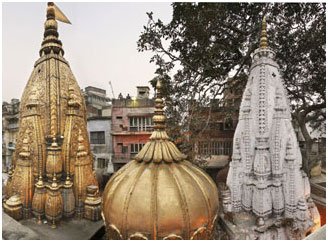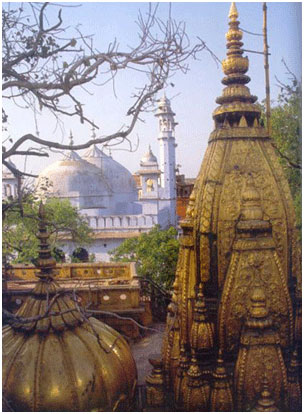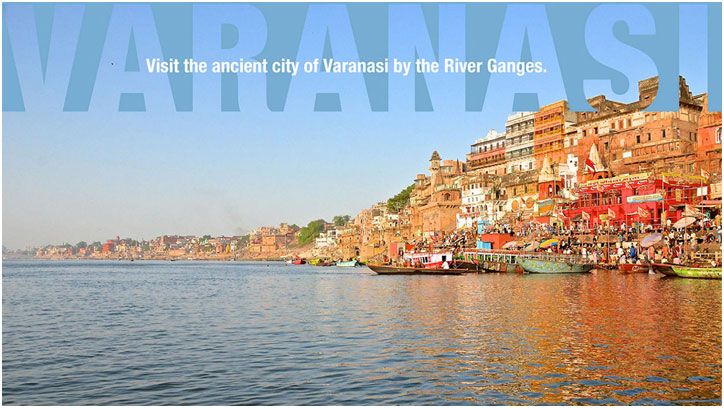
Also known as the Golden Temple, it is dedicated to Lord Shiva, the presiding deity of the city.
More than the Ghat’s and even the Ganga, the Shivalinga installed in the temple remains the devotional focus of Varanasi.
Kashi Vishwanath temple is one of the most famous temples and is dedicated to Lord Shiva. The temple stands on the western bank of the holy river Ganges and is one of the twelve Jyotirlingas, the holiest of Shiva temples. The main deity is known by the name Vishwanatha or Vishweshwara meaning Ruler of the universe. The temple town, which claims to be the oldest living city in the world, with 3500 years of documented history, is also called Kashi and hence the temple is popularly called Kashi Vishwanath temple. It has been destroyed and re-constructed a number of times in the history. The last structure was demolished by Aurangazeb, who constructed the Gyanvapi Mosque on its site. The current structure was built on an adjacent site by the Maratha monarch, Ahilya Bai Holkar of Indore in 1780. Since 1983, the temple has been managed by the government of Uttar Pradesh. During the religious occasion of Shivratri, Kashi Naresh (King of Kashi) is the chief officiating priest and no other person or priest is allowed to enter the sanctum sanctorum. It is only after he performs his religious functions that others are allowed to enter.

A simple glimpse of the Jyotirlinga is a soul-cleansing experience that transforms life and puts it on the path of knowledge and bhakti. Vishweshwara Jyotirlinga has a very special and unique significance in the spiritual history of India. Tradition has it that the merits earned by the darshan of other Jyotirlinga scattered in various parts of India accrue to devotee by a single visit to Kashi Vishwanath temple.
The temple has been visited by many great personalities- Lord Chaitanya, Lord Nityananda, Adi Shankaracharya, Goswami Tulsidas, Gurunanak, Srila Bhakti Siddhant Saraswati Thakur and several other spiritual personalities. The Kashi Vishwanath temple attracts visitors not only from India but abroad as well and thereby symbolizes man’s desire to live in peace and harmony with one another.
In 1839, Two domes of the temple were covered by gold donated by Punjab Kesari Maharaja Ranjeet Singh. Ministry of cultures & Religious affairs of U.P. Govt. took keen interest for gold plating of third dome of temple.
The temple opens daily at 2.30 a.m. Mangala Aarati takes place between 3 to 4 a.m. The ticket holders are permitted to join.
From 4 to 11 a.m: General darshan is allowed.
11.30 to 12 a.m: Mid-day Bhog Aarati is done.
Again 12 noon to 7 p.m: Devotees are free to have darshan.
From 7 to 8.30 p.m: Evening Sapta Rishi Aarati is done after which darshan is again possible until 9 p.m. when Shringar/Bhog Aarati starts.
After 9 p.m: Darshan from outside only is possible.
Shayana Aarti starts at 10.30 p.m. The temple closes at 11p.m.
| TEMPLE TIMINGS |
| TEMPLE | MANGLA | BHOG | SANDHYA | SRINGAR | SHAYAN |
| SRI VISHWANATH JI | 3.00A.M. | 1.30NOON | 7.00P.M. | 9.00P.M. | 10.30P.M. |
| SRI ANNAPURNA JI | 4.00A.M. | 11.30NOON | 7.00P.M. | 10.00P.M. | |
| SRI KALBHAIRO JI | 5.00A.M. | 01.30NOON | 8.00P.M. | 12.00P.M. | |
| SRI SANKATHA JI | 4.30/6.30A.M. | 02.30NOON | 11.00P.M. | 11.00P.M. | |
| SRI DURGA JI(DURGA KUNDA) | 5.00A.M. | 7.00P.M. | 11.00P.M. | ||
| SRI SANKAT MOCHAN | 4.30A.M. | 12.00NOON | 3.00P.M. | 8.00P.M. | 10.30P.M. |







